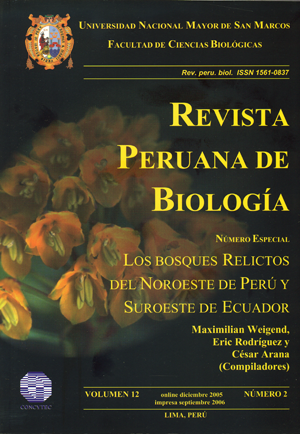Nuevos registros y nuevas especies de la flora de la zona de AmotapeHuancabamba: Endemismos y límites biogeográficos
DOI:
https://doi.org/10.15381/rpb.v12i2.2398Palabras clave:
Urtica, Ribes, bosques relictos, biodiversidad, zona de Amotape-HuancabambaResumen
Se investiga la taxonomía del grupo de Ribes andicola y Urtica para los bosques relictos presentes en la zona de Amotape-Huancabamba y especialmente aquellos de la vertiente NO del Perú. Se describen tres nuevas especies de Ribes: Ribes contumazensis como especie local endémica de Contumazá, R. colandina distribuida en los Andes desde Lambayeque y La Libertad hasta Amazonas y R. sanchezii como endémica a los bosques de altura del Marañón. Adicionalmente, la especie ecuatoriana R. austroecuadorense es registrada por primera vez para el Perú procedente de los bosques relictos de Huancabamba (Piura) y Chota (Cajamarca). Así mismo, se describen dos nuevas especies de Urtica: U. urentivelutina, endémica local a las laderas altas del Marañón cerca a Chagual (La Libertad), y U. lalibertadensis distribuida desde Otuzco hasta Tayabamba en el departamento de La Libertad. Urtica longispica es registrada como nueva especie para la flora del Peru y U. macbridei es registrada por primera vez para el norte del Perú. Urtica y el grupo Ribes andicola pueden ser considerados como indicadores de la cubierta de bosques anteriores, puesto que persisten después que los bosques han sido talados. Su distribución indica que a) alguno de los actuales fragmentos de bosque fueron alguna vez grandes bosques coherentes a modo de una faja contínua (como los de Santa Cruz y San Miguel) y b) algunas áreas que en el presente no tienen ninguna cubierta de bosques contínuos, en el pasado fueron grandes y coherentes bosques montanos (e.g., grandes partes de la Prov. Otuzco). Comparando los datos de distribución conocida para Urtica, el grupo de Ribes andicola, el grupo de Passiflora lobbii y Nasa (Loasaceae), es evidente, que a) los bosques relictos son aún muy pobremente estudiados, b) ellos son excepcionalmente ricos en taxa estrechamente endémicos, algunos de los cuales son aquí descritos y muchos de ellos indudablemente permanecen aún sin ser descubiertos y c) ellos representan los límites más sureños para muchas especies ecuatorianas y ciertos grupos de especies.Descargas
Descargas
Publicado
Número
Sección
Licencia
Derechos de autor 2005 Maximiliam Weigend, Asunción Cano, Eric F. Rodríguez

Esta obra está bajo una licencia internacional Creative Commons Atribución-NoComercial-CompartirIgual 4.0.
LOS AUTORES RETIENEN SUS DERECHOS:
a. Los autores retienen sus derechos de marca y patente, y también sobre cualquier proceso o procedimiento descrito en el artículo.
b. Los autores retienen el derecho de compartir, copiar, distribuir, ejecutar y comunicar públicamente el artículo publicado en la Revista Peruana de Biología (por ejemplo, colocarlo en un repositorio institucional o publicarlo en un libro), con un reconocimiento de su publicación inicial en la Revista Peruana de Biología.
c. Los autores retienen el derecho a hacer una posterior publicación de su trabajo, de utilizar el artículo o cualquier parte de aquel (por ejemplo: una compilación de sus trabajos, notas para conferencias, tesis, o para un libro), siempre que indiquen su publicación inicial en la Revista Peruana de Biología (autores del trabajo, revista, volumen, número y fecha).






